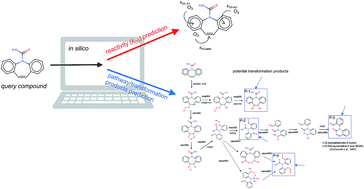A computer-based prediction platform for the reaction of ozone with organic compounds in aqueous solution: kinetics and mechanisms†
Abstract
Ozonation of secondary wastewater effluents can reduce the discharge of micropollutants by transforming their chemical structures. Therefore, a better understanding of the formation of transformation products during ozonation is important. In this study, a computer-based prediction platform for the kinetics and mechanisms of the reactions of ozone with organic compounds was developed to enable in silico predictions of transformation products. With the developed prediction platform, reaction kinetics expressed as second-order rate constants for the reactions of ozone with selected organic compounds (kO3, M−1 s−1) can be predicted based on an adapted kO3 prediction model from a previous study (Lee et al., Environ. Sci. Technol., 2015, 49, 9925–9935) (average model error of about a factor of 6 for 14 compound classes with 284 model compounds). Ozone reaction mechanisms reported in the literature have been reviewed and, using chemoinformatics tools, encoded into about 340 individual reaction rules that can be generally applied to predict the transformation products of micropollutants. Predictions for kO3 and/or transformation products were overall consistent with the experimental data for three micropollutants used as validation compounds (e.g., carbamazepine, tramadol, and triclosan). However, limitations of the current kO3 prediction platform were also identified: ambiguous assignment of the n-th highest occupied molecular orbital energy (EHOMO−n) to the reactive sites, potential errors associated with the use of a gas-phase geometry, and a poor kO3 prediction for certain compounds (cetirizine). Therefore, the current prediction tool should not be considered as a substitute for experimental studies and experimental data are still required in the future to obtain a more robust prediction model. Nonetheless, the developed prediction platform, made available as a stand-alone graphical user interface (GUI) application, will provide useful information about aqueous ozone chemistry to various groups of end-users such as environmental chemists, engineers, or toxicologists.

- This article is part of the themed collection: QSARs and computational chemistry methods in environmental chemical sciences


 Please wait while we load your content...
Please wait while we load your content...